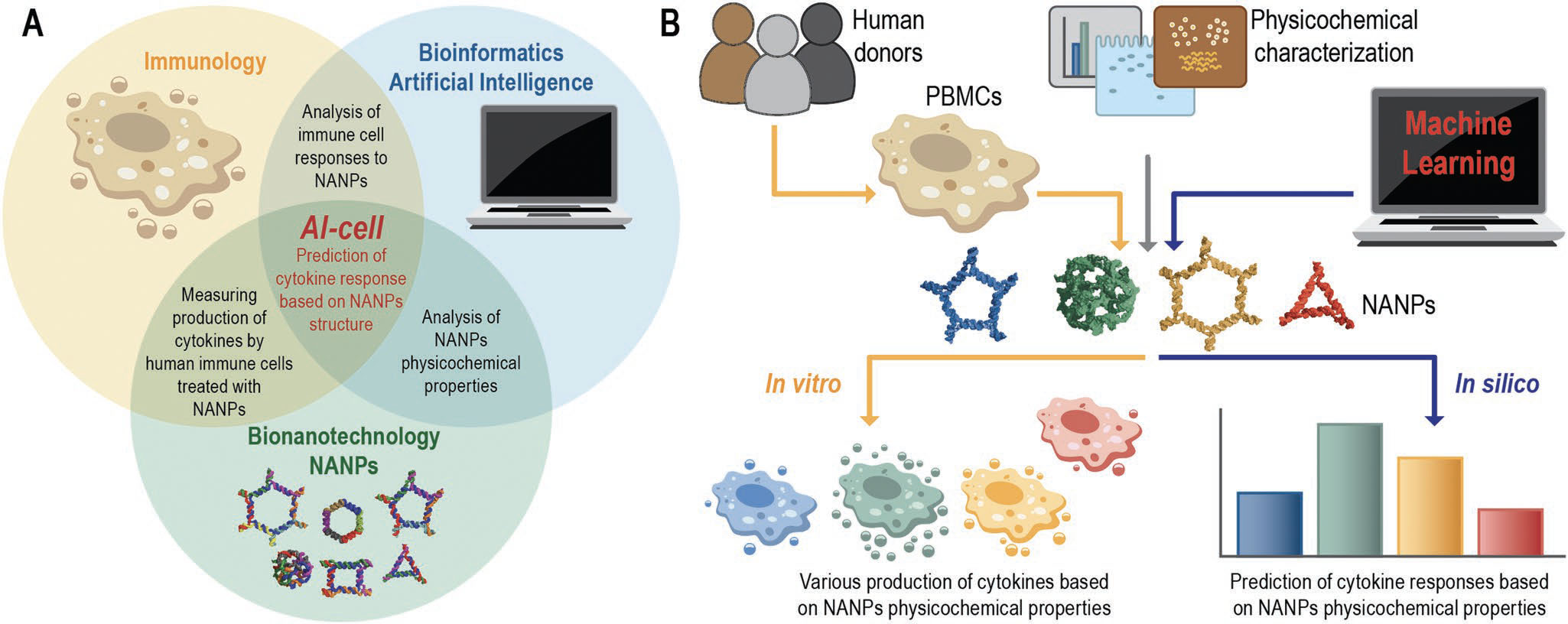| Apr 09, 2023 | |
AI-powered tool predicts human immune responses to nucleic acid nanoparticles |
|
| (Nanowerk Spotlight) As new biomedical technologies approach clinical trials, comprehending their interactions with the human immune system becomes a paramount concern. Unwanted immune recognition can result in severe side effects, which could not only halt further development of the materials under investigation but also adversely affect the entire research field. | |
| The same concept naturally applies to therapeutic nucleic acids (TNAs) that have significantly impacted the field of nanomedicine, leading to the development of nucleic acid nanoparticles (NANPs). These novel materials are engineered solely of short RNA and/or DNA strands that self-assemble into defined architectures with various compositions, sizes, and shapes, resulting in precisely controlled physicochemical properties and therapeutic functions. | |
| NANPs have the potential to treat various diseases, including cancers, infectious diseases, and cardiovascular diseases. However, understanding their interactions with the human immune system is critical for their clinical translation. | |
| “NANPs' unique properties mean that their immune recognition cannot be extrapolated from conventional TNAs,” Professor Kirill Afonin tells Nanowerk. “The ability to predict how NANPs interact with the immune system could allow for the development of tailored formulations with optimized therapeutic effects and controlled immunological activity.” | |
| Deep learning has significantly advanced various research fields, including computer vision and natural-language processing. It is also extensively used in biomedical research, such as drug discovery and genomics. In genomics, sequence-based deep learning models have surpassed classical machine learning, enabling efficient prediction of DNA and RNA sequences' function, origin, and properties through the training of neural networks on large datasets. | |
| The development of computer-assisted learning tools that would predict the immune recognition of NANPs in silico, based only on their sequence compositions, would speed up the translation of this promising technology and bring more research teams to the emerging field of RNA nanotechnology. | |
| Now, an interdisciplinary team, led by the Afonin Lab at UNC Charlotte, has developed an unprecedented artificial intelligence-driven tool that can predict the immune responses of human immune cells (specifically peripheral blood mononuclear cells, or PBMC) when they encounter nucleic acid nanoparticles or other therapeutic nucleic acids. | |
 |
|
| Conceptual representation of artificial immune cell (or AI-cell) tool. A) The initial design and synthesis of nucleic acid nanoparticles (NANPs) is followed by their physicochemical characterization and assessment of immunostimulatory potential to then be applied for predictive computational analysis of the NANPs immune responses. B) The experimental workflow used for the development of AI-cell. (Reprinted with permission by Wiley-VCH Verlag) (click on image to enlarge) | |
| The researchers reported their findings in Small ("Artificial Immune Cell, AI-cell, a New Tool to Predict Interferon Production by Peripheral Blood Monocytes in Response to Nucleic Acid Nanoparticles"). | |
| According to Afonin, this work has been a massive collaborative effort with five years of hard work and constant interactions between UNC Charlotte, the National Center for Advancing Translational Sciences (NIH), a computational team of Dr. Alexey Zakharov, and Frederick National Laboratory for Cancer Research (NCI), a team of immunologists led by Dr. Marina Dobrovolskaia. | |
| By systematically examining the physicochemical and immunological profiles of an extensive panel of diverse nanoparticles, the interdisciplinary research team collaboratively developed and experimentally validated a computational model. | |
| This model, based on the transformer architecture, is capable of predicting the immune activities of nanomaterials. The researchers utilized random forest (RF) and two distinct neural network architectures, including a recurrent neural network and a transformer neural network, to predict the immunomodulatory activity of 58 representative NANPs. | |
| The top-performing models are now freely accessible to the research community through an online tool called "Artificial Immune cell" or AI-cell. This tool can be used to predict the immunological responses of any novel nucleic acid architecture, potentially accelerating NANP design and selection for personalized immunotherapeutic approaches or immunologically safe nanoscaffolds for other applications. | |
 By
Michael
Berger
– Michael is author of three books by the Royal Society of Chemistry:
Nano-Society: Pushing the Boundaries of Technology,
Nanotechnology: The Future is Tiny, and
Nanoengineering: The Skills and Tools Making Technology Invisible
Copyright ©
Nanowerk LLC
By
Michael
Berger
– Michael is author of three books by the Royal Society of Chemistry:
Nano-Society: Pushing the Boundaries of Technology,
Nanotechnology: The Future is Tiny, and
Nanoengineering: The Skills and Tools Making Technology Invisible
Copyright ©
Nanowerk LLC
|
|
|
Become a Spotlight guest author! Join our large and growing group of guest contributors. Have you just published a scientific paper or have other exciting developments to share with the nanotechnology community? Here is how to publish on nanowerk.com. |
|
